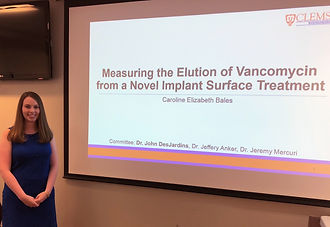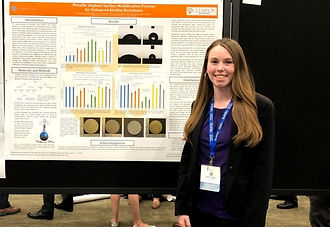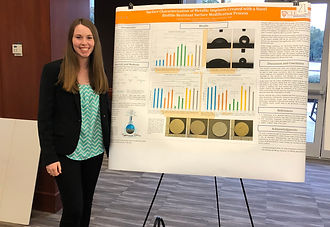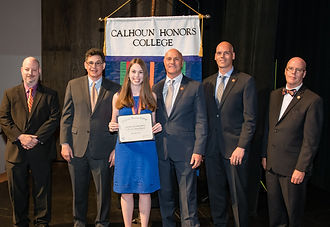PRESENTATIONS

Master's Thesis Defense - Clemson, SC
Oral Presentation
July 15, 2019
Measuring the Elution of Vancomycin from a Novel Implant Surface Treatment
Implant infections are a critical concern in the biomedical field, particularly when treating open fractures. The modification of implant surfaces to impart an infection-resistant layer has been done previously, most often through the addition of an antibiotic to the surface. The release of the antibiotic is critical to the coating’s success, as the antibiotic concentration in the body must maintain at or above the drug’s minimum inhibitory concentration long enough to prevent bacteria in the wound from adhering to the implant. This study investigated the release of the antibiotic vancomycin from a novel 3 H-vancomycin and chitosan coating to determine its elution rate and antimicrobial effectiveness.

2019 Society for Biomaterials Annual Meeting - Seattle, WA
Poster Presentation
April 04, 2019
Metallic Implant Surface Modification Process for Enhanced Biofilm Resistance
The accumulation of proteins and bacteria on implant surfaces is a critical concern in the healthcare field, as these accumulations can impair the patient healing process. One of the most widely used predictors of surface interaction with bacteria is material surface wettability, which can be used to predict interactions between a material and the surrounding environment, and, thus, predict potential colonization of bacterial strains on the material. While different bacterial strains respond differently to the hydrophobic or hydrophilic nature of the surface, most bacteria adhere more to surfaces which are more hydrophobic. Surface modifications typically affect both surface wettability and surface roughness of a material, altering the potential interaction of the material with bacteria. It is therefore important to determine how the variables of wettability and roughness are affected by new surface coating technologies. However, when a material is implanted in vivo, proteins quickly adhere to the surface and change the material’s surface characteristics. This study compares the wettability of two novel surface modification methods on simulated protein fouling exposure.

2018 Southeast Regional Biomaterials Day - Clemson, SC
Poster Presentation
November 09, 2018
Surface Characterization of Metallic Implants Created with a Novel Biofilm-Resistant Surface Modification Process
The accumulation of proteins and bacteria on implant surfaces is a critical concern in the biomedical field, especially with respect to the potential of biofilm formation on implant surfaces. Material surface wettability is often used as a predictor of surface interactions between a material and specific bacterial strains. In particular, the more hydrophobic a material is, the higher the chance of bacterial adhesion on the surface. Surface roughness has also been shown to have a relationship with biofilm formation, as rougher surfaces tend to have a stronger affinity to harbor bacterial colonies. The modification of implant surfaces to impart a biofilm resistant layer can come at the expense of increasing surface roughness, however, and it is therefore important to determine how the variables of wettability and roughness are affected by any new surface coating technologies. However, proteins will adhere to the surface of materials milliseconds after they enter the body, changing the surface properties of a material and its interactions with proteins. This study investigates the impact of surface roughness, surface wettability, and protein adhesion on the formation of biofilms on metallic implants.

2018 Biomedical Engineering Society's Annual Meeting - Atlanta, GA
Poster Presentation
October 19, 2018
Surface Characterization of Metallic Implants Created with a Novel Biofilm-Resistant Surface Modification Process
The accumulation of proteins and bacteria on implant surfaces is a critical concern in the biomedical field, especially with respect to the potential of biofilm formation on implant surfaces. Material surface wettability is often used as a predictor of surface interactions between a material and specific bacterial strains. In particular, the more hydrophobic a material is, the higher the chance of bacterial adhesion on the surface. Surface roughness has also been shown to have a relationship with biofilm formation, as rougher surfaces tend to have a stronger affinity to harbor bacterial colonies. The modification of implant surfaces to impart a biofilm resistant layer can come at the expense of increasing surface roughness, however, and it is therefore important to determine how the variables of wettability and roughness are affected by any new surface coating technologies. However, proteins will adhere to the surface of materials milliseconds after they enter the body, changing the surface properties of a material and its interactions with proteins. This study investigates the impact of surface roughness, surface wettability, and protein adhesion on the formation of biofilms on metallic implants.

Departmental Honors Thesis Defense - Clemson, SC
Oral Presentation
April 27, 2018
Surface Characterization of Metallic Implants Created with a Novel Biofilm-Resistant Surface Modification Process
This project sought to study a novel surface modification technique and how it affected surface topography and wettability. Understanding this effect allowed us to determine how biofilm-resistant these surfaces are and which ones would perform better under different circumstances.
2017 Biomedical Engineering Society's Annual Meeting - Phoenix, AZ
Poster Presentation
October 12, 2017
Wettability of a Novel Biofilm-Resistant Surface Modification Process for Metallic Implants
The accumulation of proteins and bacteria on implant surfaces is a critical concern in the biomedical field, especially with respect to the potential of biofilm formation on implant surfaces. Material surface wettability is often used as a predictor of surface interactions between a material and the surrounding environment, and is often used as a predictor of potential colonization of specific bacterial strains. Surface roughness has also been shown to have a strong relationship with biofilm formation, as rougher surfaces tend to have a stronger affinity to harbor bacterial colonies. The modification of implant surfaces to impart a biofilm resistant layer can come at the expense of increasing surface roughness however, and it is therefore important to determine how the variables of wettability and roughness are affected by any new surface coating technologies. In the current work, a novel CoBlast (C) process that impregnates alumina (A) at 50 µm grit (5) or 90 µm grit (9) sizes, with the possible addition of polytetrafluoroethylene (P) onto titanium surfaces, combined with a plasma coating process called BioDep, that coats the surface with chitosan (X) with the possible addition of vancomycin (V), were evaluated for wettability and surface roughness to determine their potential as biofilm resistant treatments on implants.
